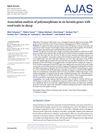TLDR KRT85 gene variations can help improve wool traits in sheep through selective breeding.
The study examined the exon 3–4 region of the ovine KRT85 gene in 463 Merino × Southdown-cross lambs, identifying two variants, A and B, with frequencies of 55.6% and 44.4%, respectively. Variant A was associated with increased greasy and clean fleece weights, while variant B was linked to a higher wool prickle factor. The genotypes AA, AB, and BB were observed with frequencies of 32.6%, 46.1%, and 21.3%, respectively. These results suggest that KRT85 variations could serve as gene markers for improving wool traits through selective breeding, though further research across different sheep breeds is necessary to validate these findings.
10 citations
,
November 2021 in “International journal of molecular sciences” Sheep and goat hair fibers are complex due to keratin-associated proteins, which are important for fiber properties and growth.
 17 citations
,
November 2017 in “Asian-Australasian journal of animal sciences”
17 citations
,
November 2017 in “Asian-Australasian journal of animal sciences” Certain gene mutations are linked to wool quality in sheep and could help in breeding for better wool.
 42 citations
,
January 2017 in “Genes”
42 citations
,
January 2017 in “Genes” The gene KAP22-1 affects wool yield and fiber shape in sheep.
83 citations
,
May 2011 in “Experimental Dermatology” Sheep have 17 keratin genes, similar to humans, but with different expression patterns affecting wool and hair.
272 citations
,
September 2001 in “Journal of Biological Chemistry” Human hair keratins were cataloged, showing their roles in hair differentiation stages.
235 citations
,
July 1999 in “Journal of biological chemistry/The Journal of biological chemistry” Human hair is made up of different keratins, some strong and some weak, with specific types appearing at various stages of hair growth.
15 citations
,
January 1993 in “DNA sequence” KRT2.13 gene is similar to KRT2.9 but not expressed in hair follicles.
65 citations
,
February 1992 in “Development” Type II keratin genes are crucial for hair follicle differentiation and have a conserved structure and expression pattern.

